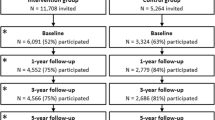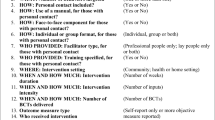Abstract
Background
Given that low physical activity levels and poor dietary intake are co-occurring risk factors for chronic disease, there is a need for interventions that target both health behaviors, either sequentially or simultaneously. Little is known about participant characteristics that are associated with better or worse response to sequential and simultaneous interventions.
Method
The 12-month Counseling Advice for Lifestyle Management (CALM) randomized trial (N = 150; Mage = 55.3 years) targeted these two behaviors either via a sequential approach — dietary advice first then exercise advice added (“Diet-First”) or exercise advice first then dietary advice added (“Exercise-First”) — or via a simultaneous approach. The objective was to examine demographic, clinical, and psychosocial moderators of intervention effects on 12-month change in (1) moderate-to-vigorous physical activity (MVPA), (2) fruit/vegetable intake, (3) caloric intake from saturated fat, and (4) weight. Hierarchical regressions first compared Diet-First to Exercise-First, followed by comparisons of these arms combined (“sequential”) to the simultaneous arm.
Results
Older age, higher baseline BMI, and lower social support were associated with higher MVPA in Exercise-First vs. Diet-First, while lower tangible support was associated with higher fruit/vegetable intake in Exercise-First but not in Diet-First. Poor sleep was associated with higher levels of MVPA in the sequential arm than in the simultaneous arm. Lower vitality was associated with greater weight loss in the sequential arm than in the simultaneous arm, while the opposite was true for those who were not married.
Conclusion
Identifying moderators of treatment response can allow the behavioral medicine field to enhance intervention efficacy by matching participant subgroups to their best-fitting interventions.
Trial Registration
NCT00131105.


Similar content being viewed by others
Data Availability
The data set used in this study is available from the corresponding author (MLP) upon reasonable request.
Abbreviations
- BMI:
-
Body mass index
- CALM:
-
Counseling Advice for Lifestyle Management trial
- CHAMPS:
-
The Community Healthy Activities Model Program for Seniors questionnaire
- CI:
-
Confidence interval
- Diet-First:
-
A sequential intervention with a focus on dietary advice for the first 4 months and then exercise advice added for the remaining 8 months
- Exercise-First:
-
A sequential intervention with a focus on exercise advice for the first 4 months then dietary advice added for the remaining 8 months
- ISEL:
-
The Interpersonal Support Evaluation List
- MHBC:
-
Multiple health behavior change
- MVPA:
-
Moderate-to-vigorous physical activity
- PAR:
-
The Stanford 7-Day Physical Activity Recall
- Sequential:
-
Sequentially delivered interventions
- Simultaneous:
-
An intervention that targeted both exercise and dietary advice concurrently
References
Ezzati M, Riboli E. Behavioral and dietary risk factors for noncommunicable diseases. N Engl J Med. 2013;369(10):954–64.
Jensen M, Ryan D, Apovian C, et al. 2013 AHA/ACC/TOS guideline for the management of overweight and obesity in adults: a report of the American College of Cardiology/American Heart Association Task Force on Practice Guidelines and The Obesity Society. Circulation. 2014;129(25 Suppl 2):S139–40.
Piercy KL, Troiano RP, Ballard RM, et al. The physical activity guidelines for Americans. JAMA. 2018;320(19):2020–8.
Pickens CM, Pierannunzi C, Garvin W, Town M. Surveillance for certain health behaviors and conditions among states and selected local areas—Behavioral Risk Factor Surveillance System, United States, 2015. MMWR Surveill Summ. 2018;67(9):1.
Heredia NI, Fernandez ME, van den Berg AE, et al. Coaction between physical activity and fruit and vegetable intake in racially diverse, obese adults. Am J Health Promot. 2019.
Prochaska JJ, Spring B, Nigg CR. Multiple health behavior change research: an introduction and overview. Prev Med. 2008;46(3):181–8.
Young DR, Vollmer WM, King AC, et al. Can individuals meet multiple physical activity and dietary behavior goals. Am J Health Behav. 2009;33(3):277–86.
Johns DJ, Hartmann-Boyce J, Jebb SA, Aveyard P, Group BWMR. Diet or exercise interventions vs combined behavioral weight management programs: a systematic review and meta-analysis of direct comparisons. J Acad Nutr Diet. 2014;114(10):1557–68.
Bandura A. Social cognitive theory of self-regulation. Organ Behav Hum Decis Process. 1991;50(2):248–87.
Annesi JJ. Supported exercise improves controlled eating and weight through its effects on psychosocial factors: extending a systematic research program toward treatment development. Issues. 2016.
Spring B, Pellegrini C, McFadden H, et al. Multicomponent mHealth intervention for large, sustained change in multiple diet and activity risk behaviors: the Make Better Choices 2 Randomized Controlled Trial. J Med Internet Res. 2018;20(6): e10528.
King AC, Castro CM, Buman MP, Hekler EB, Urizar GG Jr, Ahn DK. Behavioral impacts of sequentially versus simultaneously delivered dietary plus physical activity interventions: the CALM trial. Ann Behav Med. 2013;46(2):157–68.
Meader N, King K, Wright K, et al. Multiple risk behavior interventions: meta-analyses of RCTs. Am J Prev Med. 2017;53(1):e19–30.
Hyman DJ, Pavlik VN, Taylor WC, Goodrick GK, Moye L. Simultaneous vs sequential counseling for multiple behavior change. Arch Intern Med. 2007;167(11):1152–8.
Goodpaster BH, DeLany JP, Otto AD, et al. Effects of diet and physical activity interventions on weight loss and cardiometabolic risk factors in severely obese adults: a randomized trial. JAMA. 2010;304(16):1795–802.
Middleton KR, Anton SD, Perri MG. Long-term adherence to health behavior change. Am J Lifestyle Med. 2013;7(6):395–404.
Schulz DN, Kremers SP, Vandelanotte C, et al. Effects of a web-based tailored multiple-lifestyle intervention for adults: a two-year randomized controlled trial comparing sequential and simultaneous delivery modes. J Med Int Res. 2014;16(1).
James E, Freund M, Booth A, et al. Comparative efficacy of simultaneous versus sequential multiple health behavior change interventions among adults: a systematic review of randomised trials. Prev Med. 2016;89:211–23.
Vandelanotte C, De Bourdeaudhuij I, Brug J. Two-year follow-up of sequential and simultaneous interactive computer-tailored interventions for increasing physical activity and decreasing fat intake. Ann Behav Med. 2007;33(2):213–9.
Hekler E, Tiro JA, Hunter CM, Nebeker C. Precision health: the role of the social and behavioral sciences in advancing the vision. Ann Behav Med. 2020.
King AC, Ahn DF, Atienza AA, Kraemer HC. Exploring refinements in targeted behavioral medicine intervention to advance public health. Ann Behav Med. 2008;35(3):251–60.
Kraemer HC. Messages for clinicians: moderators and mediators of treatment outcome in randomized clinical trials. Am J Psychiatry. 2016;173(7):672–9.
Carraça EV, Santos I, Mata J, Teixeira PJ. Psychosocial pretreatment predictors of weight control: a systematic review update. Obes Facts. 2018;11(1):67–82.
Chopra S, Malhotra A, Ranjan P, et al. Predictors of successful weight loss outcomes amongst individuals with obesity undergoing lifestyle interventions: a systematic review. Obes Rev. 2021;22(3): e13148.
Duan Y, Shang B, Liang W, Du G, Yang M, Rhodes RE. Effects of eHealth-based multiple health behavior change interventions on physical activity, healthy diet, and weight in people with noncommunicable diseases: systematic review and meta-analysis. J Med Internet Res. 2021;23(2): e23786.
Amato K, Park E, Nigg CR. Prioritizing multiple health behavior change research topics: expert opinions in behavior change science. Transl Behav Med. 2016;6(2):220–7.
National Health Interview Survey. National Center for Health Statistics. 2002.
Block G, Gillespie C, Rosenbaum EH, Jenson C. A rapid food screener to assess fat and fruit and vegetable intake. Am J Prev Med. 2000;18(4):284–8.
Cohen S, Kamarck T, Mermelstein R. Perceived stress scale. Measuring stress: A guide for health and social scientists. 1994.
Beck AT, Steer RA, Brown G. Beck depression inventory–II. Psychol Assess. 1996.
Taylor JA. A personality scale of manifest anxiety. Psychol Sci Public Interest. 1953;48(2):285.
Buysse DJ, Reynolds CF III, Monk TH, Berman SR, Kupfer DJ. The Pittsburgh Sleep Quality Index: a new instrument for psychiatric practice and research. Psychiatry Res. 1989;28(2):193–213.
Neff K, King A. Exercise program adherence in older adults: the importance of achieving one’s expected benefits. Med Exerc Nutr Health. 1995;4:355–62.
Holmes TH, Rahe RH. The social readjustment rating scale. J Psychosom Res. 1967.
Myers AM, Malott OW, Gray E, et al. Measuring accumulated health-related benefits of exercise participation for older adults: the Vitality Plus Scale. J Gerontol Biomed Sci Med Sci. 1999;54(9):M456–66.
Cohen S, Hoberman HM. Positive events and social supports as buffers of life change stress 1. J Appl Soc Psychol. 1983;13(2):99–125.
Sallis JF, Grossman RM, Pinski RB, Patterson TL, Nader PR. The development of scales to measure social support for diet and exercise behaviors. Prev Med. 1987;16(6):825–36.
Garcia AW, King AC. Predicting long-term adherence to aerobic exercise: a comparison of two models. J Sport Exerc Psychol. 1991;13(4):394–410.
King AC, Baumann K, O’Sullivan P, Wilcox S, Castro C. Effects of moderate-intensity exercise on physiological, behavioral, and emotional responses to family caregiving: a randomized controlled trial. J Gerontol A Biol Sci Med Sci. 2002;57(1):M26–36.
Stewart AL, Mills KM, King AC, Haskell WL, Gillis D, Ritter PL. CHAMPS physical activity questionnaire for older adults: outcomes for interventions. Med Sci Sports Exerc. 2001;33(7):1126–41.
Sallis JF, Haskell WL, Wood PD, et al. Physical activity assessment methodology in the Five-City Project. Am J Epidemiol. 1985;121(1):91–106.
Pruitt LA, King AC, Obarzanek E, et al. Reliability of the 7-day physical activity recall in a biracial group of inactive and active adults. J Phys Act Health. 2006;3(4):423–38.
Block G, Thompson F, Hartman A, Larkin F, Guire K. Comparison of two dietary questionnaires validated against multiple dietary records collected during a 1-year period. J Am Diet Assoc. 1992;92(6):686.
Boucher B, Cotterchio M, Kreiger N, Nadalin V, Block T, Block G. Validity and reliability of the Block98 food-frequency questionnaire in a sample of Canadian women. Public Health Nutr. 2006;9(1):84–93.
Berry WD, Feldman S, Stanley Feldman D. Multiple regression in practice. Sage; 1985.
Kraemer HC, Wilson GT, Fairburn CG, Agras WS. Mediators and moderators of treatment effects in randomized clinical trials. Arch Gen Psychiatry. 2002;59(10):877–83.
Little RJ, Rubin DB. Statistical analysis with missing data, vol. 793. John Wiley & Sons; 2019.
van Ginkel JR. Significance tests and estimates for R 2 for multiple regression in multiply imputed datasets: A cautionary note on earlier findings, and alternative solutions. Multivar Behav Res. 2019;54(4):514–29.
Kraemer HC, Frank E, Kupfer DJ. Moderators of treatment outcomes: clinical, research, and policy importance. JAMA. 2006;296(10):1286–9.
Cohen S. Perceived stress in a probability sample of the United States. 1988.
Hagger MS, Wood CW, Stiff C, Chatzisarantis NL. Self-regulation and self-control in exercise: the strength-energy model. Int Rev Sport Exerc Psychol. 2010;3(1):62–86.
Gollwitzer PM, Sheeran P. Implementation intentions and goal achievement: a meta-analysis of effects and processes. In: Zanna MP, editor. Advances in experimental social psychology, vol. 38. Elsevier Academic Press; 2006. p. 69–119.
Maisano MS, Shonkoff ET, Folta SC. Multiple health behavior change for weight loss: a scoping review. Am J Health Behav. 2020;44(5):559–71.
Lawler SP, Winkler EA, Goode AD, Fjeldsoe BS, Reeves MM, Eakin EG. Moderators of health behavior initiation and maintenance in a randomized telephone counseling trial. Prev Med. 2014;61:34–41.
Luten KA, Dijkstra A, Reijneveld SA, de Winter AF. Moderators of physical activity and healthy eating in an integrated community-based intervention for older adults. Eur J Public Health. 2016;26(4):645–50.
Funding
National Institute of Diabetes and Digestive and Kidney Diseases, K23DK129805, Michele Lanpher Patel, National Heart, Lung, and Blood Institute, T32HL007034, Michele Lanpher Patel.
Author information
Authors and Affiliations
Corresponding author
Ethics declarations
Ethical Approval
All procedures performed in studies involving human participants were in accordance with the ethical standards of the institutional and/or national research committee and with the 1964 Helsinki Declaration and its later amendments or comparable ethical standards. The parent trial was approved by the Stanford Institutional Review Board. For this type of secondary data analysis study, formal consent is not required.
Consent to Participate
Informed consent was obtained from all individual participants included in the study.
Additional information
Publisher's Note
Springer Nature remains neutral with regard to jurisdictional claims in published maps and institutional affiliations.
Supplementary Information
Below is the link to the electronic supplementary material.
Rights and permissions
Springer Nature or its licensor (e.g. a society or other partner) holds exclusive rights to this article under a publishing agreement with the author(s) or other rightsholder(s); author self-archiving of the accepted manuscript version of this article is solely governed by the terms of such publishing agreement and applicable law.
About this article
Cite this article
Patel, M.L., Rodriguez Espinosa, P. & King, A.C. Moderators of a Diet and Physical Activity Intervention: who Responds Best to Sequential vs. Simultaneous Approaches. Int.J. Behav. Med. (2023). https://doi.org/10.1007/s12529-023-10223-9
Accepted:
Published:
DOI: https://doi.org/10.1007/s12529-023-10223-9




